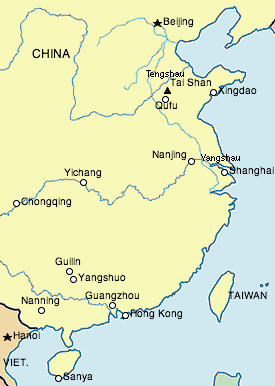Tai Shan Sacred Mountain
Sunday, November 14th, 2004
Located midway between Beijing and Shanghai, “Tai Shan” is probably the most famous of the five sacred mountains of China. According to legend Tai Shan represents the head of Pan Gu, who after creating heaven and earth, dies from exhaustion and his limbs and head fall to earth as the five mountains. Subsequent emperors were required to climb the mountain in order to be considered an appropropriate ruler. Both Confucius and Mao felt obliged to scale the summit (5068 feet).
The sacred Mount Tai (‘shan’ means ‘mountain’) was the object of an imperial cult for nearly 2,000 years, and the artistic masterpieces found there are in perfect harmony with the natural landscape. It has always been a source of inspiration for Chinese artists and scholars and symbolizes ancient Chinese civilizations and beliefs. It is an UNESCO World Heritage Site.
I had no idea what to expect but planned on spending a night on the summit so packed my pack with multiple contingencies to include extra clothing, rain gear, food, water etc. All unnecessary, of course, as vendors and shops lined the route from bottom to top altho prices became proportionately more expensive with elevation.
The majority of the route is along carved and/or constructed stone steps which are several centuries old. Multiple temples and shrines line the way. These have cultural and spiritual significance for the Chinese but without English explanation went over my head and remain largely unappreciated. Trees, under which various emperors rested, are noted and enshrined.
Along the route the Chinese would often give me the thumbs up sign–perhaps because of being a foreigner (“laowai”–the word has a derogatory connotation like farong or gringo or honkie) or perhaps my age, perhaps both. Frequently they would request (demand) to carry my backpack (I sweat easily) and were dismayed and occasionally argumentative when I communicated that I preferred to carry my own pack. My interpretation was that they felt they should be “taking care of” the foreigner.
Photos of ancient sites & scenery were encouraged but attempts to photograph poverty, filth or anything less than ideal were met with negative feedback or at least wonderment on why anyone would want to take such a picture. The Chinese have elevated posing to an art form and always include themselves in the scene.
I reached the summit about 5pm and found it to be crowded with all shapes and sizes of Chinese who had taken a bus to the half way point and then a tram the remainder of the way to the summit. As the sun set it became increasingly cold and vendors rented out Chinese military overcoats. The laowai (foreigner) had difficulty finding one that would fit–precipitating smiles to giggles to gaffaws. The lodging was somewhere on the negative side of adequate and without heat the night was cold enough to interfere with sleep.
After a knock on the door at 5 a.m. I joined a huge entourage of Chinese for a hike to a lookout where we sat and waited for the sunrise. It was spectacular with an orange globe rising from a white bank of clouds…this coupled with a lone pine tree next to a pagoda…represented my interpretation of the quintessential and mystical China.

